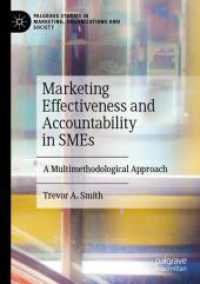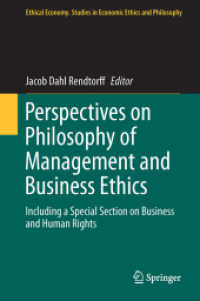- ホーム
- > 洋書
- > ドイツ書
- > Mathematics, Sciences & Technology
- > Chemistry
- > organic chemistry
Full Description
Green Chemical Synthesis with Microwaves and Ultrasound A guide to the efficient and sustainable synthesis of organic compounds
Chemical processes and the synthesis of compounds are essential aspects of numerous industries, and particularly central to the creation of drug-like structures. Their often significant environmental biproducts, however, have driven substantial innovations in the areas of green and organic synthesis, which have the potential to drive efficient, solvent-free synthesis and create more sustainable chemical processes. The use of microwaves and ultrasounds in chemical synthesis has proven an especially fruitful area of research, with the potential to produce a more sustainable industrial future. Green Chemical Synthesis with Microwaves and Ultrasound provides a comprehensive overview of recent advances in microwave- and ultrasound-driven synthesis and their cutting-edge applications.
Green Chemical Synthesis with Microwaves and Ultrasound readers will also find:
Introduction to the key equipment and tools of green chemical synthesis
Detailed discussion of methods including ultrasound irradiation, metal-catalyzed reactions, enzymatic reactions, and many more
An authorial team with immense experience in environmentally friendly organic chemical production
Green Chemical Synthesis with Microwaves and Ultrasound is ideal for chemists, organic chemists, chemical engineers, biochemists, and any researchers or industry professionals working on the synthesis of chemicals and/or organic compounds.
Contents
About the Editors xiii
Preface xv
1 Ultrasound Irradiation: Fundamental Theory, Electromagnetic Spectrum, Important Properties, and Physical Principles 1
Sumit Kumar, Amrutlal Prajapat, Sumit K. Panja, and Madhulata Shukla
1.1 Introduction 1
1.2 Cavitation History 3
1.2.1 Basics of Cavitation 3
1.2.2 Types of Cavitation 5
1.3 Application of Ultrasound Irradiation 7
1.3.1 Sonoluminescence and Sonophotocatalysis 9
1.3.2 Industrial Cleaning 10
1.3.3 Material Processing 11
1.3.4 Chemical and Biological Reactions 12
1.4 Conclusion 14
Acknowledgments 15
References 15
2 Fundamental Theory of Electromagnetic Spectrum, Dielectric and Magnetic Properties, Molecular Rotation, and the Green Chemistry of Microwave Heating Equipment 21
Raghvendra K. Mishra, Akshita Yadav, Vinayak Mishra, Satya N. Mishra, Deepa S. Singh, and Dakeshwar Kumar Verma
2.1 Introduction 21
2.1.1 Historical Background 25
2.1.2 Green Chemistry Principles for Sustainable System 28
2.2 Fundamental Concepts of the Electromagnetic Spectrum Theory 35
2.3 Electrical, Dielectric, and Magnetic Properties in Microwave Irradiation 38
2.4 Microwave Irradiation Molecular Rotation 41
2.5 Fundamentals of Electromagnetic Theory in Microwave Irradiation 42
2.5.1 Electromagnetic Radiations and Microwave 43
2.5.2 Heating Mechanism of Microwave: Conventional Versus Microwave Heating 44
2.6 Physical Principles of Microwave Heating and Equipment 46
2.7 Green Chemistry Through Microwave Heating: Applications and Benefits 53
2.8 Conclusion 57
References 57
3 Conventional Versus Green Chemical Transformation: MCRs, Solid Phase Reaction, Green Solvents, Microwave, and Ultrasound Irradiation 69
Shailendra Yadav, Dheeraj S. Chauhan, and Mumtaz A. Quraishi
3.1 Introduction 69
3.2 A Brief Overview of Green Chemistry 69
3.2.1 Definition and Historical Background 69
3.2.2 Significance 70
3.3 Multicomponent Reactions 71
3.4 Solid Phase Reactions 73
3.5 Microwave Induced Synthesis 74
3.6 Ultrasound Induced Synthesis 75
3.7 Green Chemicals and Solvents 77
3.8 Conclusions and Outlook 78
References 79
4 Metal-Catalyzed Reactions Under Microwave and Ultrasound Irradiation 83
Suresh Maddila, Immandhi S.S. Anantha, Pamerla Mulralidhar, Nagaraju Kerru, and Sudhakar Chintakula
4.1 Ultrasonic Irradiation 83
4.1.1 Iron-Based Catalysts 86
4.1.2 Copper-Based Catalysts 89
4.1.2.1 Dihydropyrimidinones by Cu-Based Catalysts 91
4.1.2.2 Dihydroquinazolinones by Cu-Based Catalysts 92
4.1.3 Misalliances Metal-Based Catalysts 94
4.2 Microwave-Assisted Reactions 97
4.2.1 Solid Acid and Base Catalysts 98
4.2.1.1 Condensation Reactions 98
4.2.1.2 Cyclization Reactions 100
4.2.1.3 Multi-component Reactions 104
4.2.1.4 Friedel-Crafts Reactions 106
4.2.1.5 Reaction Involving Catalysts of Biological Origin 107
4.2.1.6 Reduction 109
4.2.1.7 Oxidation 110
4.2.1.8 Coupling Reactions 113
4.2.1.9 Micelliances Reactions 121
4.2.1.10 Click Chemistry 125
4.3 Conclusion 127
Acknowledgments 128
References 128
5 Microwave- and Ultrasonic-Assisted Coupling Reactions 133
Sandeep Yadav, Anirudh P.S. Raman, Kashmiri Lal, Pallavi Jain, and Prashant Singh
5.1 Introduction 133
5.2 Microwave 134
5.2.1 Microwave-Assisted Coupling Reactions 135
5.2.2 Ultrasound-Assisted Coupling Reactions 142
5.3 Conclusion 150
References 151
6 Synthesis of Heterocyclic Compounds Under Microwave Irradiation Using Name Reactions 157
Sheryn Wong and Anton V. Dolzhenko
6.1 Introduction 157
6.2 Classical Methods for Heterocyclic Synthesis Under Microwave Irradiation 158
6.2.1 Piloty-Robinson Pyrrole Synthesis 158
6.2.2 Clauson-Kaas Pyrrole Synthesis 158
6.2.3 Paal-Knorr Pyrrole Synthesis 159
6.2.4 Paal-Knorr Furan Synthesis 160
6.2.5 Paal-Knorr Thiophene Synthesis 160
6.2.6 Gewald Reaction 161
6.2.7 Fischer Indole Synthesis 162
6.2.8 Bischler-Möhlau Indole Synthesis 162
6.2.9 Hemetsberger-Knittel Indole Synthesis 163
6.2.10 Leimgruber-Batcho Indole Synthesis 163
6.2.11 Cadogan-Sundberg Indole Synthesis 163
6.2.12 Pechmann Pyrazole Synthesis 164
6.2.13 Debus-Radziszewski Reaction 164
6.2.14 van Leusen Imidazole Synthesis 166
6.2.15 van Leusen Oxazole Synthesis 166
6.2.16 Robinson-Gabriel Reaction 167
6.2.17 Hantzsch Thiazole Synthesis 167
6.2.18 Einhorn-Brunner Reaction 168
6.2.19 Pellizzari Reaction 169
6.2.20 Huisgen Reaction 169
6.2.21 Finnegan Tetrazole Synthesis 171
6.2.22 Four-component Ugi-azide Reaction 172
6.2.23 Kröhnke Pyridine Synthesis 172
6.2.24 Bohlmann-Rahtz Pyridine Synthesis 173
6.2.25 Boger Reaction 174
6.2.26 Skraup Reaction 174
6.2.27 Gould-Jacobs Reaction 175
6.2.28 Friedländer Quinoline Synthesis 176
6.2.29 Povarov Reaction 176
6.3 Conclusion 177
Acknowledgments 177
References 177
7 Microwave- and Ultrasound-Assisted Enzymatic Reactions 185
Nafseen Ahmed, Chandan K. Mandal, Varun Rai, Abbul Bashar Khan, and Kamalakanta Behera
7.1 Introduction 185
7.2 Influence Microwave Radiation on the Stability and Activity of Enzymes 186
7.3 Principle of Ultrasonic-Assisted Enzymolysis 190
7.4 Applications of Ultrasonic-Assisted Enzymolysis 192
7.4.1 Proteins and Other Plant Components Can Be Transformed and Extracted 192
7.4.2 Modification of Protein Functionality 193
7.4.3 Enhancement of Biological Activity 194
7.4.4 Ultrasonic-Assisted Acceleration of Hydrolysis Time 195
7.5 Enzymatic Reactions Supported by Ultrasound 196
7.5.1 Lipase 196
7.5.2 Protease 196
7.5.3 Polysaccharide Enzymes 198
7.6 Biodiesel Production via Ultrasound-Supported Transesterification 198
7.6.1 Homogenous Acid-Catalyzed Ultrasound-Assisted Transesterification 199
7.6.2 Transesterification with Ultrasound Assistance and Homogenous Base Catalysis 199
7.6.3 Heterogeneous Acid-Catalyzed Ultrasound-Assisted Transesterification 201
7.6.4 Heterogeneous Base-Catalyzed Ultrasound-Assisted Transesterification 205
7.6.5 Enzyme-Catalyzed Ultrasound-Assisted Transesterification 207
7.7 Conclusions 207
Acknowledgments 209
References 209
8 Microwave- and Ultrasound-Assisted Synthesis of Polymers 219
Anupama Singh, Sushil K. Sharma, and Shobhana Sharma
8.1 Introduction 219
8.2 Microwave-Assisted Synthesis of Polymers 220
8.3 Ultrasound-Assisted Synthesis of Polymers 223
8.4 Conclusion 228
References 229
9 Synthesis of Nanomaterials Under Microwave and Ultrasound Irradiation 235
Ahmed A. Mohamed
9.1 Introduction 235
9.2 Synthesis of Metal Nanoparticles 236
9.3 Synthesis of Carbon Dots 239
9.4 Synthesis of Metal Oxides 240
9.5 Synthesis of Silicon Dioxide 243
9.6 Conclusion 243
References 244
10 Microwave- and Ultrasound-Assisted Synthesis of Metal-Organic Frameworks (MOF) and Covalent Organic Frameworks (COF) 249
Sanjit Gaikwad and Sangil Han
10.1 Introduction 249
10.2 Principles 250
10.2.1 Principles of Microwave Heating 250
10.2.2 Principle of Ultrasound-Assisted Techniques 250
10.2.3 Advantages and Disadvantages of Microwave- and Ultrasound-Assisted Techniques 252
10.3 MOF Synthesis by Microwave and Ultrasound Method 252
10.3.1 Microwave-Assisted Synthesis of MOF 253
10.3.2 Ultrasound-Assisted Synthesis of MOFs 256
10.4 Factors That Affect MOF Synthesis 257
10.4.1 Solvent 257
10.4.2 Temperature and pH 258
10.5 Application of MOF 260
10.6 COF Synthesis by Microwave and Ultrasound Method 262
10.6.1 Ultrasound-Assisted Synthesis of COFs 262
10.6.2 Microwave-Assisted Synthesis of COF 262
10.6.3 Structure of COF (2D and 3D) 263
10.7 Factors Affecting the COF Synthesis 266
10.8 Applications of COFs 267
10.9 Future Predictions 269
10.10 Summary 269
Acknowledgments 269
References 270
11 Solid Phase Synthesis Catalyzed by Microwave and Ultrasound Irradiation 283
R.M. Abdel Hameed, Amal Amr, Amina Emad, Fatma Yasser, Haneen Abdullah, Mariam Nabil, Nada Hazem, Sara Saad, and Yousef Mohamed
11.1 Introduction 283
11.2 Wastewater Treatment 284
11.3 Biodiesel Production 289
11.4 Oxygen Reduction Reaction 297
11.5 Alcoholic Fuel Cells 306
11.6 Conclusion and Future Plans 313
References 313
12 Comparative Studies on Thermal, Microwave-Assisted, and Ultrasound-Promoted Preparations 337
Tri P. Adhi, Aqsha Aqsha, and Antonius Indarto
12.1 Introduction 337
12.1.1 Background on Preparative Techniques in Chemistry 337
12.1.2 Overview of Thermal, Microwave-Assisted, and Ultrasound-Promoted Preparations 338
12.1.3 Significance of Comparative Studies in Enhancing Synthetic Methodologies 341
12.1.3.1 Optimization of Conditions 341
12.1.3.2 Efficiency Improvement 342
12.1.3.3 Methodological Advances 343
12.1.3.4 Sustainability and Green Chemistry 343
12.2 Fundamentals of Thermal, Microwave-Assisted, and Ultrasound-Assisted Reactions 345
12.2.1 Explanation of Thermal Reactions and Their Advantages and Limitations 345
12.2.2 Introduction to Microwave-Assisted Reactions and How They Differ from Traditional Method 346
12.2.3 Understanding the Principles and Mechanisms of Ultrasound-Promoted Reactions 347
12.3 Case Studies in Organic Synthesis 349
12.3.1 Examining Examples of Organic Reactions Performed Under Thermal Conditions 349
12.3.1.1 Esterification Reaction Under Thermal Conditions 349
12.3.1.2 Dehydration of Alcohols 349
12.3.1.3 Oxidation of Aldehydes to Carboxylic Acids Using Water 350
12.3.2 Case Studies Showcasing the Application of Microwave-Assisted Reactions 350
12.3.2.1 Microwave-Assisted C—C Bond Formation 351
12.3.2.2 Microwave-Assisted Cyclization 352
12.3.2.3 Microwave-Assisted Dehydrogenation Reactions 353
12.3.2.4 Microwave-Assisted Organic Synthesis 353
12.3.3 Highlighting Successful Instances of Ultrasound-Promoted Organic Synthesis 353
12.3.3.1 Ultrasound-Promoted in Organic Synthesis 354
12.3.3.2 Ultrasound-Promoted Oxidations 354
12.3.3.3 Ultrasound-Promoted Esterification 354
12.3.3.4 Ultrasound-Promoted Cyclization 354
12.4 Scope and Limitations 355
12.4.1 Discussing the Applicability of Each Method to Different Reaction Types 355
12.4.2 Identifying the Limitations and Challenges Faced by Each Technique 357
12.4.3 Opportunities for Combining Approaches to Overcome Specific Limitations 358
12.5 Future Directions and Emerging Trends 359
12.5.1 Overview of Recent Advancements and Ongoing Research in Thermal, Microwave, and Ultrasound-Assisted Preparations 359
12.5.1.1 Food Processing Technologies 360
12.5.1.2 Chemical Routes to Materials: Thermal Oxidation of Graphite for Graphene Preparation 360
12.5.1.3 Environmental and Sustainable Applications: Waste to Energy 361
12.5.2 Recent Findings in Microwave-Assisted Preparation 361
12.5.2.1 Catalyst 361
12.5.2.2 Nanotechnology 362
12.5.3 Food Processing Technologies 362
12.5.4 Ultrasound-Assisted Preparations 363
12.5.4.1 Biomedical 363
12.5.4.2 Artificial Intelligence (AI) 363
12.6 Identification of Potential Areas for Further Exploration and Improvement 363
12.6.1 Reaction Mechanisms and Kinetics 363
12.6.2 Synergistic Effects 364
12.6.3 Green Chemistry and Sustainability 366
12.6.4 Scale-Up and Industrial Application 366
12.6.5 Catalysis and Selectivity 367
12.6.6 In Situ Monitoring and Control 367
12.6.7 Mechanistic Studies 368
12.6.8 Temperature and Energy Management 368
12.6.9 Materials Processing 369
12.6.10 Biomedical Applications 370
12.7 The Role of Artificial Intelligence and Computational Approaches in Optimizing Preparative Techniques 370
References 372
Index 381







